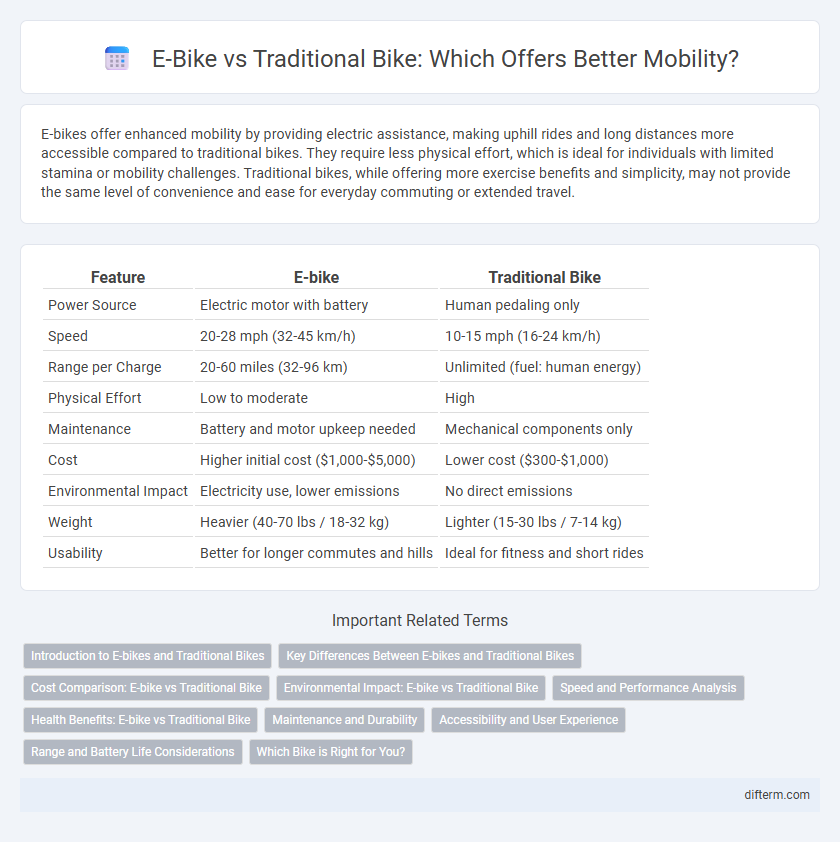E-bikes offer enhanced mobility by providing electric assistance, making uphill rides and long distances more accessible compared to traditional bikes. They require less physical effort, which is ideal for individuals with limited stamina or mobility challenges. Traditional bikes, while offering more exercise benefits and simplicity, may not provide the same level of convenience and ease for everyday commuting or extended travel.
Table of Comparison
| Feature | E-bike | Traditional Bike |
|---|---|---|
| Power Source | Electric motor with battery | Human pedaling only |
| Speed | 20-28 mph (32-45 km/h) | 10-15 mph (16-24 km/h) |
| Range per Charge | 20-60 miles (32-96 km) | Unlimited (fuel: human energy) |
| Physical Effort | Low to moderate | High |
| Maintenance | Battery and motor upkeep needed | Mechanical components only |
| Cost | Higher initial cost ($1,000-$5,000) | Lower cost ($300-$1,000) |
| Environmental Impact | Electricity use, lower emissions | No direct emissions |
| Weight | Heavier (40-70 lbs / 18-32 kg) | Lighter (15-30 lbs / 7-14 kg) |
| Usability | Better for longer commutes and hills | Ideal for fitness and short rides |
Introduction to E-bikes and Traditional Bikes
E-bikes, or electric bicycles, integrate a battery-powered motor to assist pedaling, enabling riders to cover longer distances with less physical effort compared to traditional bikes. Traditional bicycles rely solely on human power, offering a lightweight and low-maintenance option favored for fitness and simple commuting. Both e-bikes and traditional bikes contribute significantly to sustainable urban mobility by reducing carbon emissions and traffic congestion.
Key Differences Between E-bikes and Traditional Bikes
E-bikes feature an integrated electric motor that assists pedaling, enabling riders to travel longer distances with less physical effort compared to traditional bikes. Traditional bikes rely solely on human power, making them lighter and requiring no battery charging, which reduces maintenance concerns. E-bikes often include advanced components like pedal-assist sensors and rechargeable lithium-ion batteries, whereas traditional bikes emphasize simplicity and mechanical durability.
Cost Comparison: E-bike vs Traditional Bike
E-bikes generally have a higher upfront cost, ranging from $1,000 to $4,000, compared to traditional bikes, which typically cost between $200 and $1,000. Maintenance expenses for e-bikes can be more expensive due to battery replacement every 2-5 years, averaging $300 to $800, while traditional bikes have lower ongoing costs primarily for tires and brake pads. Over time, e-bikes may offer cost savings on commuting by reducing the need for public transport or vehicle fuel, but the initial investment remains significantly higher.
Environmental Impact: E-bike vs Traditional Bike
E-bikes produce significantly lower carbon emissions than gasoline-powered vehicles but have a larger environmental footprint compared to traditional bikes due to battery production and electricity use. Traditional bikes emit virtually no greenhouse gases throughout their lifecycle and require fewer resources to manufacture and maintain. Choosing e-bikes over cars can reduce urban air pollution, while traditional bikes offer the most sustainable mode of transportation with minimal environmental impact.
Speed and Performance Analysis
E-bikes deliver significantly higher average speeds, typically ranging from 20 to 28 mph, compared to traditional bikes averaging 10 to 15 mph, enhancing commuting efficiency. The integrated electric motor provides consistent power output, improving hill climbing and acceleration performance while reducing rider fatigue. Advanced battery technology and motor systems in e-bikes optimize energy use, offering reliable performance across varying terrains and distances.
Health Benefits: E-bike vs Traditional Bike
E-bikes offer cardiovascular benefits similar to traditional bikes while providing adjustable pedal assistance that accommodates varying fitness levels, making cycling accessible to a broader population. Traditional bikes promote higher-intensity workouts, enhancing endurance, muscle strength, and calorie burn more effectively than e-bikes due to continuous manual pedaling. Both modes improve mental health, reduce stress, and support joint mobility, but e-bikes can encourage longer riding distances, increasing overall physical activity.
Maintenance and Durability
E-bikes require specialized maintenance for their electric components, such as battery care and motor servicing, which can increase overall upkeep costs compared to traditional bikes. Traditional bikes generally have simpler mechanical systems, making repairs and replacements more straightforward and often less expensive. Durability of e-bikes depends significantly on battery lifespan and electronics, while traditional bikes tend to have longer physical durability under consistent maintenance due to fewer electronic parts.
Accessibility and User Experience
E-bikes enhance accessibility by providing electric assistance that reduces physical exertion, making longer distances and uphill rides more achievable for a wider range of users, including older adults and those with limited mobility. The user experience is improved with features like pedal-assist modes, integrated displays, and smoother acceleration, offering greater comfort and convenience compared to traditional bikes. This technological integration supports urban commuting and recreational use by minimizing fatigue and increasing ride efficiency.
Range and Battery Life Considerations
E-bikes offer a significantly extended range compared to traditional bikes, with modern models achieving distances of 40 to 100 miles per charge depending on battery capacity and terrain. Battery life varies by lithium-ion technology, typically retaining optimal performance for 500 to 1,000 full charge cycles, which translates to several years of daily use. Range limitations and battery degradation are critical factors for e-bike users when planning long commutes or recreational rides.
Which Bike is Right for You?
E-bikes provide electric pedal assistance, making uphill climbs and long distances easier, ideal for commuters and those seeking less physical strain. Traditional bikes offer a full workout and greater control, preferred by fitness enthusiasts and riders who enjoy a more environmentally pure experience. Choosing the right bike depends on your daily travel needs, fitness goals, and terrain preferences.
E-bike vs Traditional bike Infographic

 difterm.com
difterm.com